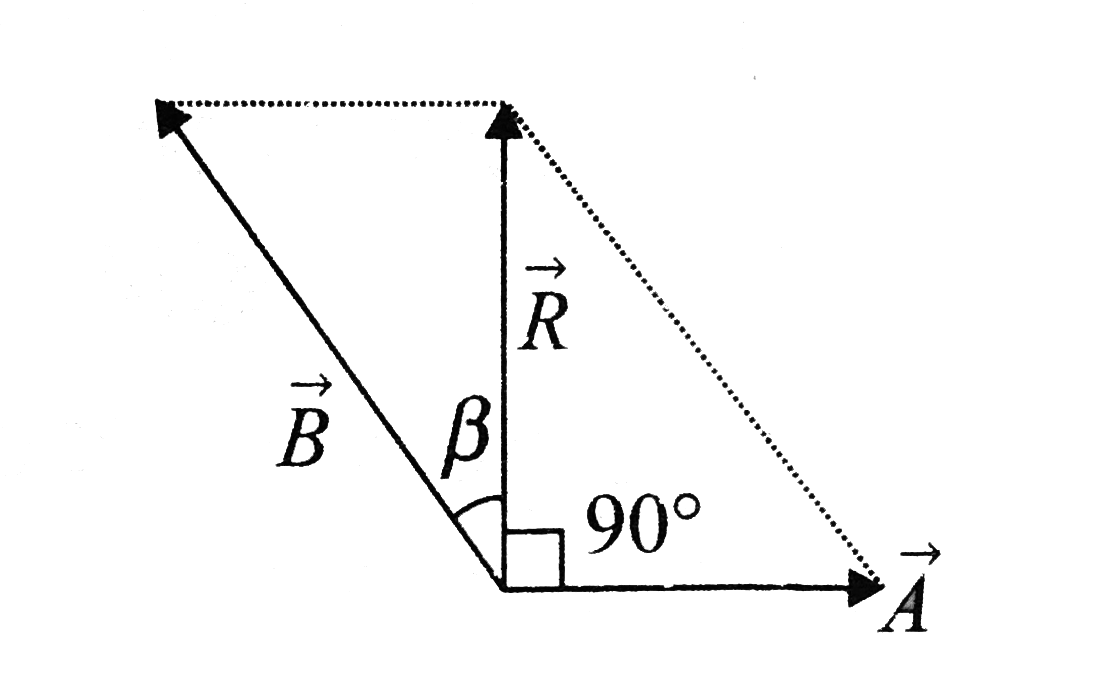The vectors →a and →b are perpendicular if :
→a.→b=0
→a.→b≠0
→a×→b=→0
→a×→b≠→0
The correct Answer is:A
To determine the condition under which the vectors →a and →b are perpendicular, we can follow these steps:
Step 1: Understanding Perpendicular Vectors
Vectors →a and →b are said to be perpendicular if the angle θ between them is 90∘.
Step 2: Using the Dot Product
The dot product of two vectors →a and →b is given by the formula:
→a⋅→b=|→a||→b|cos(θ)
Where:
- |→a| is the magnitude of vector →a,
- |→b| is the magnitude of vector →b,
- θ is the angle between the two vectors.
Step 3: Substituting the Angle
Since θ=90∘, we know that:
cos(90∘)=0
Thus, substituting this into the dot product formula gives:
→a⋅→b=|→a||→b|⋅0=0
Step 4: Conclusion
From the above steps, we conclude that:
→a⋅→b=0
This means that the vectors →a and →b are perpendicular if and only if their dot product is equal to zero.
Final Answer
The vectors →a and →b are perpendicular if:
→a⋅→b=0
---
Vectors →a and →b are said to be perpendicular if the angle θ between them is 90∘.
The dot product of two vectors →a and →b is given by the formula:
→a⋅→b=|→a||→b|cos(θ)
Where:
- |→a| is the magnitude of vector →a,
- |→b| is the magnitude of vector →b,
- θ is the angle between the two vectors.
Since θ=90∘, we know that:
cos(90∘)=0
Thus, substituting this into the dot product formula gives:
→a⋅→b=|→a||→b|⋅0=0
From the above steps, we conclude that:
→a⋅→b=0
This means that the vectors →a and →b are perpendicular if and only if their dot product is equal to zero.
The vectors →a and →b are perpendicular if:
→a⋅→b=0
Topper's Solved these Questions
- VECTOR ALGEBRA BOOK - MODERN PUBLICATIONCHAPTER - VECTOR ALGEBRA EXERCISE - Objective Type Questions (B. Fill in the Blanks)
17 Videos
- VECTOR ALGEBRA BOOK - MODERN PUBLICATIONCHAPTER - VECTOR ALGEBRA EXERCISE - Objective Type Questions (C. True/False Questions)
10 Videos
- VECTOR ALGEBRA BOOK - MODERN PUBLICATIONCHAPTER - VECTOR ALGEBRA EXERCISE - EXERCISE 10 (j) Long Answer Type Questions (II)
1 Video
- THREE DIMENSIONAL GEOMETRY BOOK - MODERN PUBLICATIONCHAPTER - THREE DIMENSIONAL GEOMETRY EXERCISE - CHAPTER TEST 11
11 Videos
Similar Questions
Knowledge Check
The following item consists of two statements, one labelled the Assertion (A) and the other labelled the Reason (R). You are to examine these two statements carefully and decide if the Assertion (A) and Reason (R) are individually true and if so, whether the reason is a correct explanation of the Assertion. Select your answer using the codes given below.
Assertion (A) : The work done when the force and displacement are perpendicular to each other is zero.
Reason (R) : the dot product →A.→B vanishes, if the vector →Aand→B are perpendicular.ABoth A and R are true and R is the correct explanation of ABBoth A and R are true but R is not the correct explanation of ACA is true but R is false.DA is false but R is true.The resultant of two vectors →A and →B is perpendicular to the vector →A and its magnitudes is equal to half of the magnitudes of vector →B (figure). The angle between →A and →B is
 A120∘B150∘C135∘DNone of these
A120∘B150∘C135∘DNone of these
Find the value of 'λ' such that the vectors →a and →b are perpendicular (orthogonal), where :
→a=7ˆi−λˆj−7ˆk,→b=4ˆi+5ˆj−ˆk
View SolutionIf ∣∣→a+→b∣∣=∣∣→a−→b∣∣, show that the vectors →aand→b are perpendicular to each other.
View SolutionIf the vectors →aand→b are perpendicular to each other, then a vector →v in terms of →aand→b satisfying the equations →v⋅→a=0,→v⋅→b=1and[→v→a→b]=1 is
View SolutionThe vectors →a and →b are not perpendicular and →c and →d are two vectors satisfying : →b×→c=→b×→d,→a⋅→d=0 . Then the vector →d is equal to : (1) →b−⎛⎝→b.→c→a.→d⎞⎠→c (2) →c+⎛⎝→a.→c→a.→b⎞⎠→b (3) →b+⎛⎝→b.→c→a.→b⎞⎠→c (4) →c−⎛⎝→a.→c→a.→b⎞⎠→b
View SolutionLet the unit vectors →a and →b be perpendicular to each other and the unit vector →c be inclined at an angle θ to both →a and →b. If →c=x→a+y→b+z(→a×→b) then
View SolutionThe resultant of two velocity vectors →A and →B is perpendicular to →A. Magnitude of Resultant →R is equal to half magnitude of →B. If the angle between →A and →B is (30θ)∘, then value of θ is ?
View Solution
